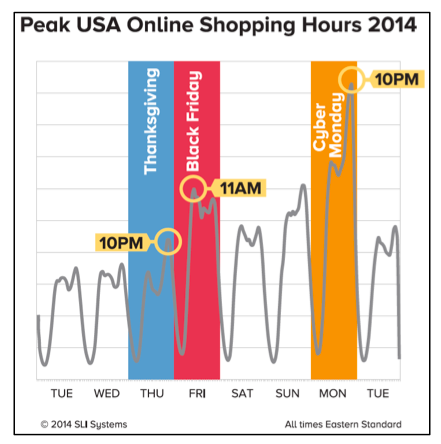By Tim Callan, SLI Systems

Holiday planning is accelerating at lightning speed, so it’s imperative that retailers take a close look at prior holiday seasons, and ever-changing consumer preferences, to apply lessons learned to clinch sales this year.
After studying e-Commerce site activity across 600 retailer web sites and analyzing more than 65 million queries during the 2014 holiday season, SLI Systems found that global peak shopping days and times are experiencing a dramatic shift that could impact the timing of critical promotions. Consumers are shopping during days and times that were previously considered taboo for this type of activity.
It’s time for retailers to take note of trends in peak traffic to ensure they don’t miss big opportunities to reach their buyers when they are actually shopping — especially from their smartphones and tablets — and deliver a personalized experience for gift givers.
Avoid Site Stress By Planning For Peaks
Based on last year’s performance, we expect 2015’s peak online holiday shopping hour to be around 10:00 p.m. ET on Cyber Monday. However, in today’s omnichannel era, consumers also are looking for deals online during the days traditionally known to lure brick-and-mortar shoppers. Ensure your site can seamlessly manage these three peaks in traffic during the 2015 holiday season.

The number of night owls has grown. Although Cyber Monday (December 1 last year) held its record in the U.S. with almost 30% more online shopping activity than any other shopping day during the 2014 Thanksgiving-to-Cyber Monday timeframe, the day’s late peak shopping hour of 10:00 p.m. ET nearly spilled into the next day.
Another notable spike in shopping activity was at 10:00 p.m. ET on Thanksgiving Day, the night before the renowned Black Friday. And, retailer web sites saw yet another spike in shopping activity on November 30, the night before Cyber Monday.
These shoppers are going online earlier than many retailers realize. You need to make sure your merchandizing programs are ready.
Holiday shoppers aren’t willing to wait for your site to load either. With 47% of users expecting a web page to load in fewer than two seconds, speed is crucial. Slower web sites increase bounce rates and decrease conversions, so stress test your sites to manage surges. Ensure your web infrastructure and content delivery network are properly configured to avert any downtime. If needed, identify scripts and elements that can load later in the page cycle to improve performance. A great way to measure how your site loads compared to your competitors is at www.webpagetest.org.
Serve Up Relevant Merchandising And Recommendations
Online shoppers are on a mission during peak holiday hours. Whether showrooming in a store on a smartphone or browsing from a desktop at home (or the office), today’s online shopper is either hunting for a deal or just trying to get the job done. Three best practices will help ensure sites connect shoppers with the products they are most likely to buy, boosting conversion and keeping the sale:
- Check your merchandising and product mix: Know the right products to offer and display these products first on your category pages to increase conversion. All category pages should be automatically merchandised based on user behavior, such as clicks, conversions, sales and margin, to ensure the most relevant products are displayed first.
- Use gift finders: ‘Tis the season for hosting first-time site shoppers looking for gifts. A parametric search provides a guided shopping experience and walks the user down a path. Allow for price range, gender, color, product segments and other parameters to quickly get the customer to relevant products and increase conversion.
- Make personalized recommendations: Offering shoppers contextually relevant products enhances the experience and increases conversion and cart size. As customers move through the site, make more granular recommendations. For instance, show “top sellers” on the home page, and as they go deeper into the site, based on behavior, show them recommendations such as “customers who viewed this item also viewed” or “frequently bought together.” At the cart, suggest related accessories. Take advantage of the months ahead to test as many variances as you can on key pages — even the call-to-action verbiage for each recommendation, showing context — to see which perform best.
Get Ready For The Post-Mobilegeddon Holidays
In addition to reducing friction for the mobile user by decreasing the number of form fields at checkout, putting the search near the top of the screen or using predictive analysis that auto completes queries, there is a new consideration in order to attract and convert the skyrocketing number of mobile users: Being mobile friendly according to Google and Bing.
The SLI 2014 peak online shopping hours study found nearly 40% of the online shopping during the 2014 holiday season was conducted on mobile devices — and yet 21% of the 500 largest North American e-retailers by sales don’t have mobile-optimized sites (Internet Retailer Top 500 Guide).
In a post-mobilegeddon world, retailers need to ensure they are ready for the mobile masses who will hit their sites this holiday. Heavily contributing to Google’s new “mobile-friendly” signal is whether or not visitors, after landing on a mobile page, can easily complete the tasks they want to accomplish solely using the mobile site. For instance, when visitors on smartphones search for new holiday pajamas at WebUndies.com, the company’s mobile-friendly site helps them easily find and buy the sleepwear they want, which in turn helps WebUndies fare better in Google smartphone rankings.
Given mobile’s space and speed challenges, the search box is the best gateway to finding products and content on mobile sites. A good search experience has a big impact on engagement metrics, which affects a site’s mobile-friendly’ signal and mobile search ranking.
Holiday shoppers (now increasingly night owls) are beating retailers to the punch on unexpected days, times and channels. By timing key promotions accordingly and optimizing mobile sites, savvy online retailers can take advantage of these new opportunities and have a jump on their competition during the 2015 holiday season.
As CMO for SLI Systems, Tim Callan is focused on driving sales growth within the e-Commerce sector and increasing SLI’s market share with its cloud-based search and navigation offerings. He previously served as CMO at RetailNext, a leading provider of in-store big data and analytics solutions, and as VP of marketing for online security leader Verisign, where he led the creation and launch of the Verisign Secured seal. Callan currently sits on the board of IT security company DigiCert and has served on the board of the Online Trust Alliance, a vendor-neutral organization dedicated to creating a more trustworthy online ecosystem. A 20-year technology industry veteran, Callan also has held marketing executive positions at Melbourne IT Digital Brand Services and Caere, which later became Nuance.






